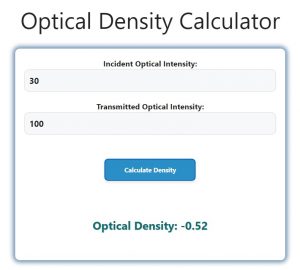About Optical Density Calculator (Formula)
Optical density (OD) is a crucial measurement in fields like biology, chemistry, and physics, where it is used to quantify the concentration of a substance in a solution by measuring the amount of light absorbed. The Optical Density Calculator simplifies the process of calculating OD, helping you determine the concentration of your sample based on light transmission.
Formula
The formula to calculate optical density is:
Optical Density = -log10(Transmitted Intensity / Incident Intensity)
Where:
- Transmitted Intensity is the intensity of light that passes through the sample.
- Incident Intensity is the intensity of light that initially strikes the sample.
How to Use
Using the Optical Density Calculator is straightforward:
- Enter Transmitted Intensity: Input the intensity of light that passes through the sample.
- Enter Incident Intensity: Provide the initial intensity of light before it enters the sample.
- Calculate: The calculator will instantly provide the optical density based on the inputs.
Example
Suppose you have a sample where:
- Transmitted Intensity = 30 units
- Incident Intensity = 100 units
Using the formula:
Optical Density = -log10(30 / 100) = -log10(0.3) ≈ 0.52
The optical density of the sample is approximately 0.52.

FAQs
- What is optical density?
Optical density is a measure of how much light is absorbed by a sample. It is used to determine the concentration of substances in solution. - Why is optical density important?
Optical density is crucial in various scientific applications, including spectroscopy and microbiology, as it helps quantify the amount of a substance present in a sample. - What units are used for optical density?
Optical density is a unitless measure since it is based on the logarithm of a ratio of intensities. - How does optical density relate to absorbance?
Optical density and absorbance are often used interchangeably, though absorbance can also refer specifically to measurements in a cuvette with a known path length. - What is the significance of a higher optical density?
A higher optical density indicates that more light is absorbed by the sample, which usually correlates with a higher concentration of the absorbing substance. - Can optical density be negative?
No, optical density cannot be negative because the ratio of transmitted to incident light is always between 0 and 1, resulting in a positive logarithmic value. - What if the transmitted intensity is equal to the incident intensity?
If the transmitted intensity equals the incident intensity, the optical density is zero, indicating no absorption. - How does path length affect optical density?
Optical density is independent of path length when calculated using the ratio of transmitted to incident light, but absorbance calculations often incorporate path length. - Can I calculate concentration from optical density?
Yes, concentration can often be derived from optical density using Beer’s Law, which relates absorbance to concentration. - What if my sample scatters light?
Optical density primarily measures absorbance, but if your sample scatters light, the reading may be affected, leading to inaccuracies. - Why use log10 in the formula?
The logarithm base 10 is used to express the relationship between the transmitted and incident light intensities on a logarithmic scale, which aligns with human perception of intensity changes. - Can optical density be greater than 1?
Yes, optical density can be greater than 1, indicating that a significant portion of the light is absorbed by the sample. - What is the difference between transmittance and optical density?
Transmittance is the fraction of light that passes through a sample, while optical density quantifies the light absorbed based on transmittance. - Is optical density affected by wavelength?
Yes, optical density varies with wavelength, as different substances absorb light differently at various wavelengths. - Can optical density be used for turbid samples?
While optical density is intended for clear solutions, it can be used for turbid samples with caution, as scattering might affect the results. - How does temperature influence optical density?
Temperature can affect the physical properties of the sample, potentially altering the optical density measurement. - What if my sample has multiple absorbing species?
If multiple species are present, the overall optical density is the sum of the contributions from each species, depending on their concentrations and absorption characteristics. - Can I use the optical density for colorimetric assays?
Yes, optical density is commonly used in colorimetric assays to determine the concentration of colored compounds in solution. - How do I calibrate my optical density measurements?
Calibration involves measuring the optical density of standards with known concentrations to create a calibration curve for determining unknown concentrations. - Is optical density the same as optical path difference?
No, optical density refers to light absorption, while optical path difference involves phase differences in light waves traveling through different mediums.
Conclusion
The Optical Density Calculator is an essential tool for scientists, researchers, and students working in various fields, including biology, chemistry, and physics. By providing quick and accurate calculations of optical density, this tool helps you analyze the concentration of substances in your samples, making it easier to conduct experiments and obtain reliable results. Whether you’re measuring the growth of bacterial cultures or analyzing chemical reactions, understanding optical density is key to accurate data interpretation.
Related: